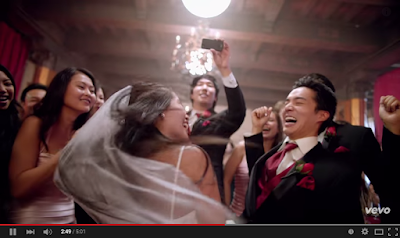1. A relationship between the lyrics and the visuals, which illustrates, amplifies or contradicts the lyrics.
In Maroon 5's "Sugar", the band visits various weddings which amplifies the song's connotations of love which it's lyrics are trying to express.
 |
| Maroon 5's "Sugar" |
2. Thought beats: seeing the sounds (seeing what they mean or represent in your head).
There are three ways visuals are used to promote a song:
Illustrate: Music videos use certain images and shots to illustrate/explain the meaning of lyrics to their songs and the genre.
Disjuncture: In this situation, the meaning of the song is completely ignored in the music video.
Amplify: This is when the images and camera shots are manipulated and shown repeatedly throughout the music video and is drummed into our vision.
There are three ways visuals are used to promote a song:
Illustrate: Music videos use certain images and shots to illustrate/explain the meaning of lyrics to their songs and the genre.
Disjuncture: In this situation, the meaning of the song is completely ignored in the music video.
Amplify: This is when the images and camera shots are manipulated and shown repeatedly throughout the music video and is drummed into our vision.
In Swedish House Mafia's "Don't You Worry Child" featuring John Martin, when the beat drops the video cuts in time with the music's rhythm which creates further meaning to the experience of watching and listening to the song video.
 |
| Swedish House Mafia's "Don't You Worry Child" featuring John Martin |
3. Genre-related style and iconography present.
Kanye West's "Only One" is influenced by a dream which Kanye had, in which, Kanye dreamed that his mother gave him knowledge on how to raise his daughter, North. North West can be seen in the video and is a metaphor for Kanye's "Only One." Kanye's frequently stands in a posture where his wedding ring is visible which implies that he is bound to his wife, Kim Kardashian. His wedding band is an example of iconography.
 |
| Kanye West's "Only One" featuring Paul McCartney |
4. Multiple close-ups of the main artist or vocalist: the creation of a star image to promote a recognisable brand image.
Most of the video for Kanye West's "Homecoming" features close-ups of Kanye, this promotes his recognisable brand image through what he's wearing for example.
 |
| Kanye West's "Homecoming" |
5. Voyeurism often plays a major part, especially in relation to females.
Rita Ora's "Poison" is about a love so bad, that it's bad for her. For no reason other than male gratification, Rita can frequently be seen scantily dressed.
 |
| Rita Ora's "Poison" |
6. Intertextual references to other media texts may be present, especially, in humorous videos.
The screenshot below, taken from Michael Jackon's "Beat It" is an intertextual reference to the 1961 American musical, West Side Story.
The screenshot below, taken from Michael Jackon's "Beat It" is an intertextual reference to the 1961 American musical, West Side Story.
 |
| Michael Jackson's "Beat It" |